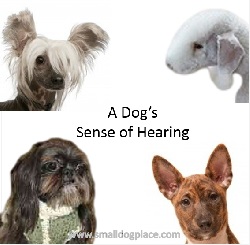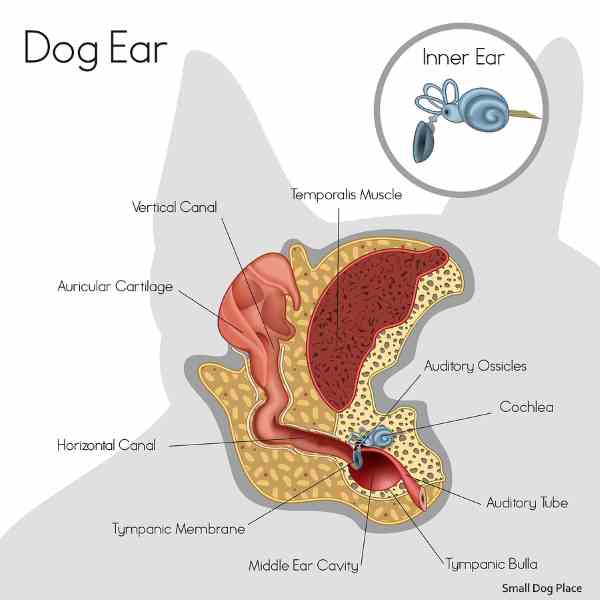- Small Dog Place Home
- Dog Senses
- Dog's sense of hearing
Dogs sense of hearing
Dog's Sense of Hearing by Janice Jones
Dogs' Sense of hearing is truly remarkable considering they begin life with sealed ears, unable to hear at all.
When it comes to the sense of hearing, your small dog’s ability to hear far outranks yours.
Even with floppy ears, their hearing is more sensitive and versatile than yours. Dogs with ears that stand upright have even better hearing.
You share the same ability to hear low frequency sounds, but there are high-pitched sounds that we cannot hear and they can hear.
To get some idea of this ability, think about the piano with its 88 keys. You would need to add four more octaves about the highest note to hear what dogs can hear. It is easy to forget and get annoyed at this ability in our fur babies.
When all is quiet and still, your dog suddenly perks up, runs to the door or window and starts to bark. You reluctantly follow only to see nothing. What you could not see, they can hear.
I always joke that my dogs are barking at the squirrels and chipmunks in the neighbor’s yard, but in reality, they may be doing just that.
Did You Know?
- Did you know that a dog's sense of hearing is so acute that they can detect sounds at frequencies as high as 65,000 Hz? In comparison, humans can only hear up to about 20,000 Hz.
- Did you know that dogs have 18 or more muscles in their ears that allow them to tilt, rotate, and move their ears independently for better sound detection?
- Did you know that a dog's ability to hear high-pitched sounds makes them incredibly effective at detecting ultrasonic frequencies that are inaudible to the human ear, such as those emitted by small rodents or dog whistles?
- Did you know that dogs can hear sounds from much farther distances than humans? On a quiet day, they can perceive sounds from as far as a mile away.
- Did you know that puppies begin to hear at around two weeks old, but it isn't until they reach about eight weeks that their sense of hearing fully develops to resemble that of adult dogs?
- Did you know that some dog breeds, especially those with acute hearing like the German Shepherd and the Cocker Spaniel, are often used in roles requiring advanced auditory skills, such as search and rescue and hearing assistance for the deaf?
Dog's Sense of Hearing
Puppies are born deaf with their ears sealed shut. By about two weeks of age, their eyes begin to open and the ears follow shortly afterwards. By the time a puppy reaches four weeks old they are hearing as well as an adult dog and can hear about four times the distance of a human with normal hearing.
Why Do Dogs Hear Better Than Humans?
Dogs can hear better than humans for four reasons. The remarkable dogs sense of hearing can be summed up as
- Anatomy
- Muscles
- Frequencies
- Selective Hearing
A Dog's Anatomy Allows Them to Hear Better.
The anatomy of yours and your dog’s ears is very similar with a few exceptions. One difference lies in the ear flap or pinna. Your ears are attached to the side of your head facing sideways.
A dog's ear, especially those dogs who hold their ears erect have an advantage over people because sounds can be detected in many different directions. There is even a hearing difference among dog breeds. Those with floppy ears covered with hair won't be able to hear as well as those with erect ears and no hair.
Ear Muscles Make a Big Difference for Dogs.
Dogs sense of hearing rely on their more than 18 muscles at the base of their ears. Compare that to our 6 ear muscles. Eighteen muscles seem like a lot, but consider the cat has 30!
This allows them to move their ears to pick up sounds in many different directions. Think of these muscles as tiny instruments moving an antennae or radar in the direction of the sound. They can turn, raise and lower their ears, even tilt them in different directions.
People, on the other hand, have limited ability to move their ears. Most cannot move their ears at all. How many people do you know that can wiggle their ears?
The Frequency Range of Dogs is Superior to Humans.
Dogs can attribute their ability to hear sounds at high frequency to their evolutionary past. Wild dogs, wolves, and foxes prey on small rodents that make high-pitched sounds as they move. The ability to hear these sounds give dogs an advantage when hunting their prey.
Humans can hear between 20 and 20,000 Hz which seems like a lot. Dogs, however can hear a frequency range of 40 to 60,000 Hz. The smaller the number the lower the sound and their higher the number the higher the pitch. As an example, a dog whistle emits a sound above 20,000 Hz which means people can't hear it but dogs can.
A Dog's Sense of Hearing Depends on Selective Hearing
Another unique characteristic that does possess and people do not is their ability to hear sounds with each ear independently. They can be listening to normal house sounds and pick up something outside at the same time.
Fortunately with this amazing hearing ability they also have a way to filter out sounds. They have selective hearing choosing which sounds they will pay attention.
Have you ever noticed that dogs will sleep soundly through a television show only to wake up abruptly at the sound of a barking dog on the TV?
Hearing Problems in Dogs
Dogs begin to lose their hearing as they age similar to people. Ear infections, trauma, and loud noises also lead to hearing loss.
Some dogs suffer from congenital deafness, meaning they are born deaf. There are at least 100 breeds that been identified as having the potential for congenital deafness.
29 Small Breed Dogs with Potential for Congenital Deafness
A BAER (Brainstem Auditory Evoked Response) test to detect activity in the auditory pathways to the brain. It is performed by a veterinarian on puppies.
Types of Dog Ears
The Shape of a dog's ear has some correlation between the dog's sense of hearing. A dog with a prick ear will likely hear better than one with a drop ear.
 Prick Ear of a Westie
Prick Ear of a Westie Rounded Ear of a Frenchie
Rounded Ear of a Frenchie Bat ear of a Welsch Corgi
Bat ear of a Welsch Corgi Drop ears of a Beagle
Drop ears of a BeagleHow to Protect a Dog's Sense of Hearing
To protect our dog’s hearing, prompt attention and treatment for ear infections is important. Since we know that loud noises can harm our fur baby’s ears as well as our own, we would do well to avoid situations where our hearing could be compromised. Thunderstorms and Fireworks are two well known causes of distress in some dogs.
This amazing
ability to hear does have its drawbacks. Just as people filter out unnecessary incoming
visual pictures, dogs learn to filter out invasive sounds. If they don’t some of these dogs will suffer
from phobias of fireworks, thunderstorms and even sirens.
One of my dogs, a little Maltese named Jasmine, hates garbage trucks and will
bark and race to the door every time one stops at or near the house. Perhaps the sounds generated with trash being compacted has a negative effect on her ear. This dog's sense of hearing is extremely keen.
Dogs with these auditory sensitivities can benefit from music therapy as a way to sooth and create a calm environment.
Related
If you found The Dogs Sense of Hearing Helpful, check out these other senses.
Seeing: A Dog's Sense of Sight
Smelling: A Dog's Sense of Smell
Tasting: A Dog's Sense of Taste
Touching: A Dog's Sense of Touch
References
What Shape is Your Dog's Ear? by Stanley Coren
About Janice (author and voice behind this site)
Janice Jones has lived with dogs and cats for most of her life and worked as a veterinary technician for over a decade. She has also been a small-breed dog breeder and rescue advocate and holds academic training in psychology, biology, nursing, and mental health counseling. Her work focuses on helping dog owners make informed, responsible decisions rooted in experience, education, and compassion.
When not writing, reading, or researching dog-related topics, she likes to spend time with her six Shih Tzu dogs, her husband, and her family, as well as knitting and crocheting. She is also the voice behind Miracle Shih Tzu and Smart-Knit-Crocheting
Does This Article Deserve Your Thumbs Up?
We always appreciate your support and encouragement. Your thumbs up means so much to us. Please like this article.
If you find this page or any page on Small Dog Place Helpful, or useful in anyway, I'd love it if you would click the small heart found on the bottom right of each page.
You can also share or bookmark this page -- just click on the:

Free Monthly Newsletter
Sign Up for Our Free Newsletter and get our Free Gift to You.
my E-book, The Top 10 Mistakes People Make When Choosing a Dog (and how to avoid them)



